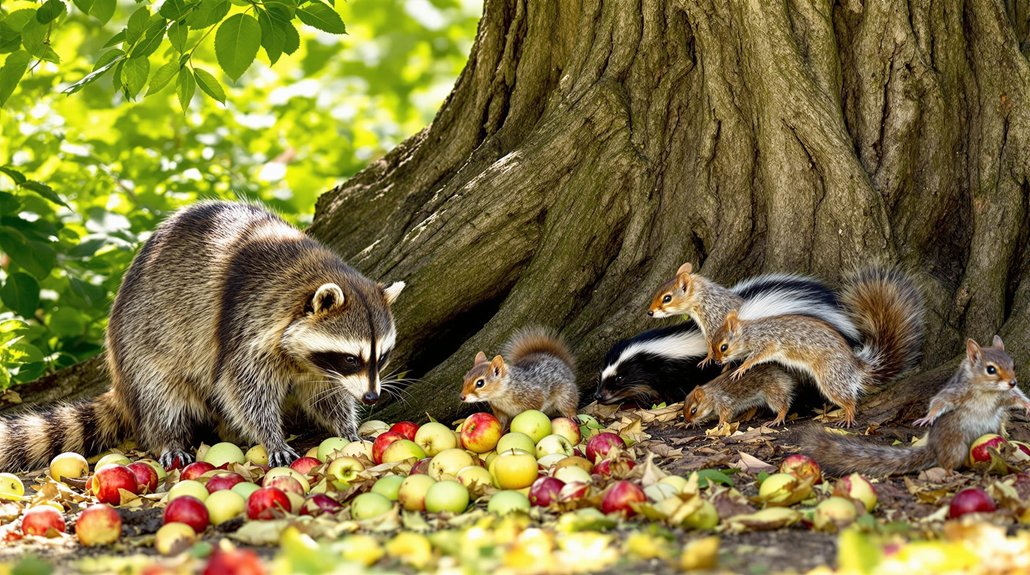Southwestern Michigan is home to several common nuisance animals. Raccoons often raid garbage and pet food, especially at night. Squirrels frequently invade gardens, causing damage to plants and crops. Opossums serve as nature's clean-up crew by eating insects and small rodents but can be seen rummaging through trash. Skunks are notorious for their strong odor and can become a problem if food is left outside. Finally, urban coyotes are adapting to city life and may pose a threat to small pets. Understanding these animals can help manage their presence effectively. There is more to uncover about their habits and solutions.
Key Article Highlights
- Raccoons are nocturnal, intelligent scavengers that often raid trash for food scraps and can be deterred by securing garbage bins.
- Squirrels frequently invade gardens, raiding fruits and vegetables; physical barriers and certain herbs can help keep them away.
- Opossums are beneficial nocturnal scavengers that help control pests and carry few parasites, enhancing ecological balance in the area.
- Skunks, known for their strong odor, forage at night for insects and fruits; securing trash can minimize their presence.
- Coyotes are adapting to urban areas, scavenging for food and posing a risk to small pets, especially during nighttime hours.
Raccoons and Their Habits
Raccoons, often recognized for their masked faces and nimble paws, are common nuisance animals in Southwestern Michigan. Their behavior varies with the seasons, as they are most active during the night. Raccoons are curious and intelligent creatures, often exploring their surroundings in search of food. This adaptability makes them frequent visitors to urban areas, where they rummage through trash and gardens for sustenance.
The raccoon diet is diverse, consisting mainly of fruits, nuts, insects, and small animals. They are opportunistic feeders, which means they will eat whatever is available. This includes pet food left outside, birdseed, and even human food scraps. Their ability to manipulate objects with their paws allows them to access food sources that may be closed off to other animals.
Understanding raccoon behavior and diet can help homeowners take preventive measures. Securing trash cans and not leaving pet food outside can reduce encounters with these animals. By recognizing their habits, individuals can create an environment that discourages raccoons from becoming a nuisance. Addressing these factors is essential for maintaining a peaceful coexistence with these clever creatures.
Squirrels: The Garden Bandits
Squirrels are another common nuisance in Southwestern Michigan, particularly in residential gardens. Their playful nature and agile movements make them skilled at raiding gardens. Squirrel behavior often includes digging in the soil and climbing plants to reach fruits, vegetables, and flowers. This can lead to significant damage and frustration for gardeners.
To guarantee garden protection, it is essential to understand how to deter these garden bandits effectively. One strategy is to use physical barriers, such as fences or netting. These can prevent squirrels from accessing vulnerable plants. Additionally, planting certain herbs, like mint or rosemary, can help repel squirrels.
Another effective measure is securing trash bins and compost piles. Squirrels are attracted to food sources, and keeping these areas clean will reduce their visits. Using motion-activated sprinklers can also startle them away.
Opossums: Nature's Clean-Up Crew
Opossums are often overlooked in discussions about nuisance animals, but they play an essential role in maintaining ecological balance. Their behavior is unique among North American marsupials. Opossums are nocturnal creatures, meaning they are active at night and often seen scavenging for food. They eat a variety of things, including insects, small rodents, and even carrion. This diet makes them valuable as nature's clean-up crew.
The benefits of opossums extend beyond just their eating habits. They help control the population of ticks and other pests that can spread diseases. By consuming ticks, they reduce the risk of Lyme disease in humans and pets. Opossums are also known for their remarkable ability to carry few parasites, making them less harmful to the environment.
Moreover, opossums are generally non-aggressive. When threatened, they often play dead, a behavior that can deter predators. This unique approach to survival helps maintain their population while protecting local ecosystems. To sum up, rather than viewing opossums as nuisance animals, we should appreciate their significant contributions to our environment. Their behavior and benefits highlight their important role in ecological health.
Skunks: Odorous Intruders
Skunks are often considered odorous intruders in Southwestern Michigan. Their strong scent can be quite unpleasant and is a primary reason for their nuisance status. Understanding skunk behavior is vital for managing their presence. Skunks are nocturnal creatures, often active at night, foraging for food. They eat insects, fruits, and small animals, which can lead them to human habitats.
Effective odor control is essential when dealing with skunks. Avoid leaving pet food outside and secure garbage cans. Homeowners should also seal entry points to prevent skunks from nesting under decks or porches.
Here is a brief overview of common skunk behaviors and management tips:
| Skunk Behavior | Management Tips |
|---|---|
| Nocturnal foraging | Keep food sources indoors |
| Territorial marking | Use repellents and barriers |
| Digging for insects | Maintain a clean yard |
| Seeking shelter | Seal access points |
Taking these steps can help reduce skunk encounters. Understanding their behavior and implementing odor control measures will create a less inviting environment for these odorous intruders.
Coyotes: Urban Adaptations
Coyotes are increasingly becoming a common sight in urban areas of Southwestern Michigan. This adaptation to city life showcases their remarkable ability to thrive in various environments. Urban hunting has become a key aspect of coyote behavior, allowing them to find food in places where they can avoid human interaction.
Coyotes often exhibit the following behaviors in urban settings:
- Scavenging: They search through trash cans and dumpsters for food.
- Hunting small pets: Coyotes may target small dogs and cats, especially during nighttime.
- Using green spaces: Parks and vacant lots serve as hunting grounds and resting spots.
These adaptations help coyotes survive in cities while maintaining their natural instincts. They are skilled at maneuvering through urban landscapes, which enhances their chances of finding food. As they become more familiar with human activity, their presence may create concerns for residents. Awareness of coyote behavior is essential for minimizing conflicts. Understanding the dynamics of urban hunting can help communities develop strategies to coexist with these adaptable animals, ensuring both safety and respect for wildlife.
Frequently Asked Questions
What Are the Signs of an Animal Infestation in My Home?
Imagine a silent storm brewing indoors. Signs of an animal infestation include strange noises at night, droppings, gnaw marks, and unusual behavior from pets. Recognizing these signs is essential for addressing potential animal behavior issues effectively.
How Can I Safely Deter These Nuisance Animals?
To safely deter nuisance animals, utilize humane traps to capture them without harm. Additionally, apply natural repellents such as essential oils or vinegar around entry points to discourage their presence while ensuring a safe environment.
Are There Any Legal Restrictions on Trapping Nuisance Animals?
Trapping regulations vary by jurisdiction and aim to balance animal welfare with human interests. It is crucial to familiarize yourself with local laws, as illegal trapping can result in significant penalties and harm to wildlife populations.
What Should I Do if I Encounter a Wild Animal?
In wildlife encounters, observe the animal's behavior from a safe distance. Remain calm and avoid sudden movements. If necessary, slowly back away to prevent startling the animal, ensuring both your safety and the animal's well-being.
How Do These Animals Impact Local Ecosystems?
These animals impact local ecosystems by influencing ecosystem balance through their interactions. They can affect food webs, competition for resources, and habitat structure, which ultimately shapes the dynamics of the ecosystem and its overall health.

